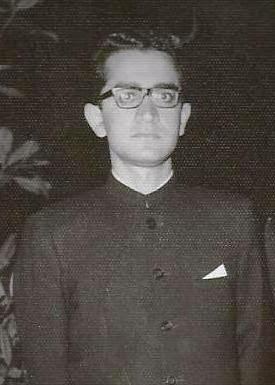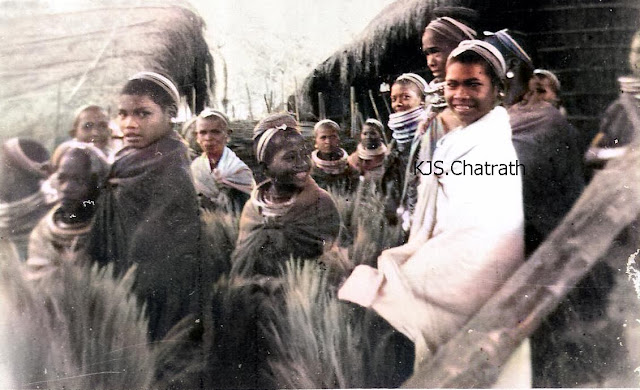'One dark night in Rourkela fifty years back.... ' by K J S Chatrath
Like most of my service colleagues, I too went through an amazing array
of administrative experiences during the first two years of my service
career. That is when after the initial training, an IAS officer is given
his first posting as an SDO/SDM/Sub-Collector. I was posted in Rourkela
in Orissa in my second Sub-Divison in 1971-1972. With the passage of
time, the memories of that year had startted fading. Till two days age
when I received an email from Prasanna Misra, who was the Additional
District Magistrate of Rourkela during that year. He has sent me an
extract from his blog "JITAMANYU" which I am reproducing below with his
kind permission:
"HOW GAS LEAK IN ROURKELA WAS HANDLED
Nearly forty years ago, in the early seventies, I was in Rourkela as the Additional District Magistrate. Kanwal Jeet Singh Chatrath was the SDO, Panposh. His house was just at the back of our house; or, rather, our house was just behind his house. It was around eleven in the evening when I was forced out of my bed one day to respond to some commotion very close to the window of our bedroom. I saw around twenty persons led by Chatrath. They spoke to me agitatedly on something while pointing out to the sky with specks of dark cloud. Though listening to the visitors, I was in deep sleep and nothing got registered in my mind. I returned to my bedroom abruptly without any response from my side and realised that Chatrath was nice enough to take the crowd back to wherever it had come from. Back on bed, I tried to sleep again; but could not. Went out to see in the sky the spectacle that was being shown in vain to me by the visitors. Our houses in Uditnagar being close to the steel plant one always saw the glow of bright lights of the steel mill illuminating the low heights of the night sky above. I saw huge moving columns of dark cloud emanating from the factory premises. There was smell of a chemical, somewhat irritating. My heart sank; sleep had vanished. I set myself on a mission mode all to myself. My telephone was the only tool to fight the emergency. There was no response from nearly twenty relevant numbers I contacted. People were in deep sleep or even if some one was not, preferred not to take the call. At last, one kind soul responded, around one in the morning. Mr. Ramesh Pant, a senior Engineer of the steel mill was a close friend. He promised to look into the problem. Most employees of the steel mill lived in the steel township, away from the factory and had not encountered the gas. After about an hour Mr. Pant called back. The problem had been fixed; emission of gas had stopped. I thanked myself; did not like to wake up Chatrath. Kept the development to myself. Mr Pant had explained to me what went wrong that night.
Sulphur is used for production of sulphuric acid that is required for production of ammonium sulphate and for pickling of cold rolled coil in the steel mill. Sulphur gets converted to sulphuric acid through contact process comprising three stages. First stage is the burning of sulphur in air to make sulphur dioxide gas. This gets converted in the second stage to sulphur trioxide with vanadium oxide acting as catalyst. The catalyst does not work in temperature below 400 degrees Celsius. They do the conversion at a temperature of 450 degree Celsius. In the final stage, sulphur trioxide is first absorbed into concentrated sulphuric acid producing a thick fuming liquid called oleum, which then is mixed with great care with water to produce sulphuric acid. The sulphur trioxide is not mixed directly with pure water to avoid a highly exothermic reaction, which would produce a fine mist of sulphuric acid that is difficult to condense and could escape to pollute the air. Strict limitations are set on the release of sulphur dioxide gas into the air as a waste product as the gas contributes to global warming and causes acid rain.
In the night shift of that fateful day, somehow the acid circulation pump failed to function that stopped circulation of 98% sulphuric acid required for absorption of sulphur trioxide and sulphur dioxide gases. Evidently this failure led to escaping of the sulphur trioxide and sulphur dioxide fumes into the atmosphere causing irritation to the public and workers in the steel mill. The effect was more pronounced in Uditnagar area as wind was blowing in that direction. When the problem was fixed, the sulphuric acid plant was stopped and gradually atmosphere was cleared of the polluting fumes.
The next morning I received a long wireless message in which government’s grave anxiety over the leakage of gas had been expressed and I was asked why I had not reported this to the government and also to indicate the latest position. I informed the government how the situation was tackled in that night itself. I still feel it is better to handle many things single handed for quicker and effective solution. If possible, we should avoid disturbing people while they are in sleep and thereby avoid panic and confusion. There are however occasions when we need collective action and we even have to ask people to vacate their homes, even at night; but a civilian should exercise his discretion on case to case basis as each case is different from the other. He should not associate others with the primary aim of passing on the buck. He should not also show off saying “he did it alone”. He is paid for doing it. We need not deploy a battalion of sepoys to scare a jackal. I am laughing while I write humorously that my good friend Kanwal Jeet should not have disturbed my sleep that night. He should have allowed me to inhale sulphur dioxide and sulphur trioxide gases for a few more hours."
I thanked Shri Prasanna Misra for his nice write-up and have added a P.S. to his blog:
"PS:
Do you remember Sir, that next day early in the morning the dashing Collector/DM of the district (Mr. Ashok Mubayi) drove from his headquarter 100 kms away straight to my house. He asked me to narrate what had happened. After I finished he asked "So, what do you plan to do". I told him point blank that I was going to issue a Show Cause notice u/s 133 of the Cr.P.C. by name and by designation to the top man of the Rourkela Steel Plant Dr. PL Agarwal".
"Hmmm" said the Collector and asked me if I knew that Dr. Agarwal was equivalent in rank to an Additional Secretary of Government of India. No Sir, I said and added that it did not make any difference to the alleged criminal liablity of a person.
The Collector came closer to me, patted me on the back and said "You know since Prasanna is the senior most govt. official in Rourkela, I will let him handle this matter." And then said, "Come let us go to Prasanna's house and have some coffee there."
No comments:
"HOW GAS LEAK IN ROURKELA WAS HANDLED
Nearly forty years ago, in the early seventies, I was in Rourkela as the Additional District Magistrate. Kanwal Jeet Singh Chatrath was the SDO, Panposh. His house was just at the back of our house; or, rather, our house was just behind his house. It was around eleven in the evening when I was forced out of my bed one day to respond to some commotion very close to the window of our bedroom. I saw around twenty persons led by Chatrath. They spoke to me agitatedly on something while pointing out to the sky with specks of dark cloud. Though listening to the visitors, I was in deep sleep and nothing got registered in my mind. I returned to my bedroom abruptly without any response from my side and realised that Chatrath was nice enough to take the crowd back to wherever it had come from. Back on bed, I tried to sleep again; but could not. Went out to see in the sky the spectacle that was being shown in vain to me by the visitors. Our houses in Uditnagar being close to the steel plant one always saw the glow of bright lights of the steel mill illuminating the low heights of the night sky above. I saw huge moving columns of dark cloud emanating from the factory premises. There was smell of a chemical, somewhat irritating. My heart sank; sleep had vanished. I set myself on a mission mode all to myself. My telephone was the only tool to fight the emergency. There was no response from nearly twenty relevant numbers I contacted. People were in deep sleep or even if some one was not, preferred not to take the call. At last, one kind soul responded, around one in the morning. Mr. Ramesh Pant, a senior Engineer of the steel mill was a close friend. He promised to look into the problem. Most employees of the steel mill lived in the steel township, away from the factory and had not encountered the gas. After about an hour Mr. Pant called back. The problem had been fixed; emission of gas had stopped. I thanked myself; did not like to wake up Chatrath. Kept the development to myself. Mr Pant had explained to me what went wrong that night.
Sulphur is used for production of sulphuric acid that is required for production of ammonium sulphate and for pickling of cold rolled coil in the steel mill. Sulphur gets converted to sulphuric acid through contact process comprising three stages. First stage is the burning of sulphur in air to make sulphur dioxide gas. This gets converted in the second stage to sulphur trioxide with vanadium oxide acting as catalyst. The catalyst does not work in temperature below 400 degrees Celsius. They do the conversion at a temperature of 450 degree Celsius. In the final stage, sulphur trioxide is first absorbed into concentrated sulphuric acid producing a thick fuming liquid called oleum, which then is mixed with great care with water to produce sulphuric acid. The sulphur trioxide is not mixed directly with pure water to avoid a highly exothermic reaction, which would produce a fine mist of sulphuric acid that is difficult to condense and could escape to pollute the air. Strict limitations are set on the release of sulphur dioxide gas into the air as a waste product as the gas contributes to global warming and causes acid rain.
In the night shift of that fateful day, somehow the acid circulation pump failed to function that stopped circulation of 98% sulphuric acid required for absorption of sulphur trioxide and sulphur dioxide gases. Evidently this failure led to escaping of the sulphur trioxide and sulphur dioxide fumes into the atmosphere causing irritation to the public and workers in the steel mill. The effect was more pronounced in Uditnagar area as wind was blowing in that direction. When the problem was fixed, the sulphuric acid plant was stopped and gradually atmosphere was cleared of the polluting fumes.
The next morning I received a long wireless message in which government’s grave anxiety over the leakage of gas had been expressed and I was asked why I had not reported this to the government and also to indicate the latest position. I informed the government how the situation was tackled in that night itself. I still feel it is better to handle many things single handed for quicker and effective solution. If possible, we should avoid disturbing people while they are in sleep and thereby avoid panic and confusion. There are however occasions when we need collective action and we even have to ask people to vacate their homes, even at night; but a civilian should exercise his discretion on case to case basis as each case is different from the other. He should not associate others with the primary aim of passing on the buck. He should not also show off saying “he did it alone”. He is paid for doing it. We need not deploy a battalion of sepoys to scare a jackal. I am laughing while I write humorously that my good friend Kanwal Jeet should not have disturbed my sleep that night. He should have allowed me to inhale sulphur dioxide and sulphur trioxide gases for a few more hours."
I thanked Shri Prasanna Misra for his nice write-up and have added a P.S. to his blog:
"PS:
Do you remember Sir, that next day early in the morning the dashing Collector/DM of the district (Mr. Ashok Mubayi) drove from his headquarter 100 kms away straight to my house. He asked me to narrate what had happened. After I finished he asked "So, what do you plan to do". I told him point blank that I was going to issue a Show Cause notice u/s 133 of the Cr.P.C. by name and by designation to the top man of the Rourkela Steel Plant Dr. PL Agarwal".
"Hmmm" said the Collector and asked me if I knew that Dr. Agarwal was equivalent in rank to an Additional Secretary of Government of India. No Sir, I said and added that it did not make any difference to the alleged criminal liablity of a person.
The Collector came closer to me, patted me on the back and said "You know since Prasanna is the senior most govt. official in Rourkela, I will let him handle this matter." And then said, "Come let us go to Prasanna's house and have some coffee there."




Comments
Post a Comment